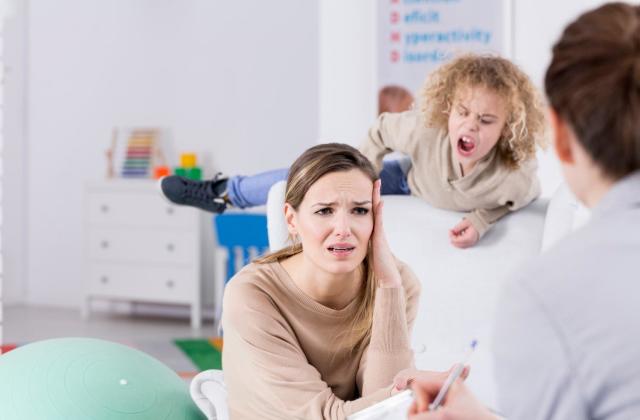Does Your Child Need an Energy Healer?
 The hospital staff were at a loss: A young patient with leukaemia was writhing in pain and inconsolable. She hadn't slept in days.
The hospital staff were at a loss: A young patient with leukaemia was writhing in pain and inconsolable. She hadn't slept in days.
Then Dr. Joy Weydert, a paediatrician who was chief of integrative pain management at Children’s Mercy Kansas City in Missouri at the time, stepped in. The girl, who was about 13 years old, had maxed out on pain medications and refused integrative therapies like guided imagery and massage, even though she'd found relief from them before. "She was beside herself she was so uncomfortable," Weydert remembers.
So Weydert, now a clinical professor of integrative medicine and paediatrics at the University of Kansas Health System in Kansas City, Kansas, pulled one more tool out of her toolkit: energy healing. While the practice can take many forms, in this case, it involved gentle touch and guidance on breathing regulation.
Within 10 minutes, the patient began settling down, and within 20, she stopped wiggling and steadied her breathing, Weydert says. After no more than 30 minutes had passed, the girl was asleep for the first time in days. When she woke up the next morning, she said, "Do that to me again!" Weydert recalls. She taught the technique to the girl's mother, who continued to use it at home each night. "It empowered her to be able to help out," Weydert says.
What is Energy Healing?
The CHO: See our own What is Healing? Section here: http://www.the-cho.org.uk/about-healing/what-is-healing/
Energy healing can describe any therapy that aims to affect the energy field – or those invisible forces around and in the body you may simply call your "personal space" or the vibe you give off – with compassion and positive intention, often in an effort to encourage the body's natural ability to heal. Diane Goldner, an energy healer in Santa Monica, California, likens it to fixing a problem on a computer document not by clicking into the document itself, but by changing something broader within the computer. "It's like opening a zip file and all the contents of the zip file open up," says Goldner, who was a sceptical journalist covering the topic before becoming so convinced of its power she changed careers.
In adults, research has shown energy healing can decrease pain, increase relaxation, improve dementia symptoms in people with the condition and alleviate emotional suffering, says Dr. Ann Marie Chiasson, an integrative family medicine physician and the co-director of the University of Arizona Center for Integrative Medicine's fellowship in integrative medicine.
In babies and children, the evidence is more limited, but still encouraging enough that a clinical report on paediatric integrative medicine written by the American Academy of Pediatrics' Section on Integrative Medicine included biofield or energy therapies like healing touch, therapeutic touch and spiritual healing among those complementary and alternative medicine therapies that are safe and effective for children. (The AAP itself has no formal policy position on energy healing.)
For example, a 2012 study on paediatric cancer patients found that kids who received healing touch experienced decreased pain, stress and fatigue – as did their parents and caregivers. A 2015 study of infants in the NICU found measures of heart rate, oxygen content in blood and pain improved after receiving massage or healing touch. "When used in conjunction with conventional therapies, children get the best of all possible outcomes," says Weydert, the chair-elect of the AAP's Section on Integrative Medicine.
Why? That's harder to say, but when it comes to energy healing that uses touch, much of it may be attributable to the hormone oxytocin, which is released in response to the right kind of touch, Chiasson explains. Oxytocin, which tamps down the body's stress response, is critical in physical, behavioural and social development since, among many roles, it promotes trust and social bonding. Without enough of it, children can develop attachment and other disorders, Chiasson says. "The thing that creates oxytocin the fastest is the right quality of touch," she says. "It has to be compassionate or caring or loving touch. Hurried touch in mammals creates anxiety, but loving touch [is] relaxing."
How hands-off healing therapies might work is even more difficult to understand. Goldner, for instance, often performs remote healing sessions, which she says can work "on a quantum level" even if the person is on the other side of the world and she knows nothing more than their first name. While non-touch energy healing is tough to research, one 1998 double-blind, randomised trial of 40 AIDS patients found that, after six months, those who had received distance healing sessions had fewer and less severe illnesses, almost four fewer doctor visits on average, better moods, fewer hospitalizations and almost three fewer days in the hospital on average when they were admitted.
The CHO: See our meta-analysis results for more evidence of the benefits of non-contact healing.
Is It Right for Your Child?
Goldner has worked with children and babies with all sorts of conditions including behavioural issues, cancerous tumours and severe scoliosis requiring surgery every nine months. (She also works with adults including doctors and nurses, Olympic athletes and law firm partners.)
In many situations, "it's a kinder, gentler way to treat children," Weydert finds. "When I can use homeopathy instead of an antibiotic for a kid with an earache; if I can use energy medicine or hypnosis instead of narcotics for pain management, how much better is that?"
There are very few risks associated with energy healing itself, so long as it doesn't mean rejecting appropriate conventional medical care when needed. Even so, it can be pricey – an hour-long session with Goldner costs $200. It's typically not covered by insurance as a stand-alone therapy, but some hospital-based clinicians trained in energy healing may integrate the energy therapies into care that's covered by insurance. Another challenge is finding a practitioner with appropriate training and experience, since there are many types of training and no one credentialing or oversight organization for healers.
"Some people will take a weekend course and open up shop, and then there a lot of people who get more in-depth practice," Weydert says. She suggests asking your paediatrician for a recommendation, although many remain sceptical of the practice and other non-conventional therapies because they understandably want to protect kids and families from scammers, she finds.
The CHO: Luckily in the UK we have voluntary self-regulation for many complementary therapies (of which Healing is one). UK Healers hold a register of healers meeting their quality criteria. You may also contact us for details of healers near to you or to request distant healing.
One safe – and cheap – alternative? Trying it yourself. Parents can learn healing touch practices like infant massage, for example, by searching for a local class led by someone they like and who has been practicing energy healing for at least three years, Chiasson says. For many parents, "healing" – which can look just like holding or touching your child in a comforting, loving way – is instinctual. Kids know intuitively what they like and don't like too. "If the child doesn't like it," Chiasson says of a healing session, "don't keep doing it. Trust the experience of the child."
Source: https://health.usnews.com/wellness/articles/2018-06-05/does-your-child-need-an-energy-healer







